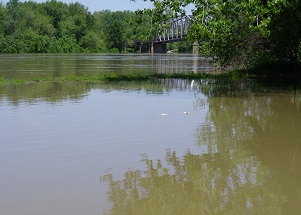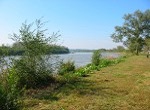Flood Prevention Basics for Communities: What Can You Control?
Last Updated: May 19, 2024
Despite the term "natural disaster," humans living in cities, towns, and neighborhoods can and should engage in a substantial amount of flood prevention. As climate change has made extraordinary storms ever more commonplace, communities are casting about in a search for better approaches to preventing loss of property and even life.
Except in unusual cases of dam failure or landslide, a flood is the result of some combination of weather, geology, soils, impervious surfaces (surfaces that water cannot seep into), poor subdivision design and maintenance, failing levees, and vegetation or lack of it. Communities can control those last four factors that impact flood damage.

1. Reducing the amount of impervious surface
This is a major flood prevention measure. Examples of impervious surfaces are concrete and asphalt paving, as well as buildings. Impervious surface causes water to run off toward a man-made or natural drainage system before the stormwater has an opportunity to percolate into the soil. The runoff also moves faster when there are no plant textures present to slow its progress. This greater velocity is nearly as vicious as volume in causing damage.
So if your city still requires a quantity of parking that results in lots frequently looking about a quarter full, if you still tell a business owner how many spaces to build, and if you still tell homeowners that they can't have grass strips in between tire tracks in their driveways, you could remedy some of these requirements as first steps in reducing the frequency of flooding.
2. Improving Subdivision Design and Maintenance
The quality of subdivision design lies directly within the control of a local government, and the planning commission and any available professional planning or engineering staff should take the lead. Many argue that subdivision approval is largely a matter of assuring that a checklist in the subdivision regulation has been followed.
However, the planning commission and governing body has an opportunity to make certain that the checklist itself is conducive to flood prevention and control.
As extreme weather seems to be increasing in frequency, it is worthwhile to consider more reliance on the 500-year floodplain than the 100-year floodplain. This particularly may be true if the community has many unplatted areas vulnerable to flooding and pushing the floodwaters downstream to the next subdivision. If you don't understand the difference, check out the explanation below.
We also should say that if large swaths of your jurisdiction are undeveloped, you might want to work with a buildout scenario (that is, accounting for all the development that zoning allows) rather than either of the federal floodplain designations. We say this because the federal floodplain maps rely on historical data, rather than looking ahead to the future.
Cluster housing and related techniques, where building lots are grouped into certain portions of the overall plat while other land is reserved for conservation and water storage, can be very useful. In instances of considerable topographic variation within a single lot, the local government can and should consider carefully the configuration of lots to assure that each lot has a suitable building site that falls within zoning setback requirements.
Lastly we mention subdivision maintenance because a fairly large proportion of the new subdivisions approved in the U.S. will be governed by a homeowners association. Most HOAs are not equipped in the slightest to deal with maintenance of detention ponds or elaborate landscaping regimes designed for flood prevention, nor do they have enough revenue to hire quality engineering firms. We know firsthand from reading the questions that are submitted to this website that often homeowners associations cease to exist, were never formed in the first place, or become dysfunctional venues for petty rivalries. Local governments need to consider whether they themselves should assume responsibility for flood control structures and measures designed for flood prevention.
3. Minimizing reliance on levee protection
While levees may be appropriate when something already built must be protected, they also are prone to failure, especially when they are earthen levees common in some parts of the world.
A second unpleasant truth about levees is that they simply displace water, forcing it downstream faster than would otherwise be the case. In plain language, that means that you are merely sending your flooding a few miles down the way toward your neighbor. That's not very responsible.
4. Planting and maintaining appropriate vegetation, often native plants
The value of plant materials in processing stormwater runoff is three-fold: (a) they slow the rate (speed) of runoff, which allows streams to "catch up" with the amount of rain or snow melt coming their way, (b) their slowing of the flow allows some moisture to percolate into the soil, where plants uptake some water for themselves and let the leftover water seep deeper to that the groundwater recharges, and (c) they capture some sediment and clean up some pollutants as water passes through. The first two points are major flood prevention steps for smaller streams.
Not all vegetation is equal in slowing down and absorbing stormwater. Turf grass, mowed to a typical lawn height, has shallow roots compared with the plants that are to your area. Turf grass does not store as much water, and due to its short height, it also does not slow the velocity as much as a taller native planting plan.
Types of Floods
Floods may be characterized as flash floods, which usually occur on smaller streams and rivers, or the more slow-moving riverine floods. Flash floods are quite dangerous because people sometimes try to walk or drive through rising water and underestimate the difficulty of the task. Overflowing rivers and creeks cause extensive property damage, and if people insist on returning to flood-damaged homes, mold and other health-related issues are additional hazards to be considered.
Current climate change patterns seem to indicate that humid areas will receive even more moisture in the future, while dryer climates receive even less. This increase in rainfall in humid areas is very likely to increase the frequency of flooding. So flood prevention is a timely topic. It also plays into an emerging way of looking at city planning, called resiliency planning. For more on this, see our answer to a site visitor question about the meaning of resiliency planning.
Understanding Flood-Related Terms
The terminology of flooding is important to master if you are a community leader or activist in a flood-prone area. These are the important concepts:
- Base flood. The base flood level has at least a 1 percent chance of being reached each year. Note that this does not mean you can't have the base flood this year because it happened last year or last month. It's just a probability statement. For practical purposes, consider this the same as the 100-year flood, in which the probability is that the land would flood once every 100 years.
- Floodway. The floodway is the actual stream or river plus the adjacent area that is required to discharge the base flood without raising the water elevation more than one foot. So our editorial comment is that clearly the floodway needs to be kept clear of buildings, debris, and obstruction of any type.
- Floodplain. The term floodplain is often used to mean the area outside of the floodway, but within the limits of the 100-year flood. A floodplain thus is wider than the floodway in most circumstances, although a bluff or other absolute barrier could mean that the boundary of the floodplain and floodway would be the same.
- 100-year flood, 500-year flood, 2-year flood, and so forth. This does not mean that this area probably would flood only once every 100 years, 500 years, or 2 years. The 100-year flood does mean that this is the flood level that statistically could be expected once in 100 years. You might well have two 100-year floods only a year apart. This is a measure of probability, but there's no guarantee that nature will be random in its distribution of flooding. Do everything you can to help property owners and would-be homebuyers understand this concept.
- FIRM map. This is the U.S. Flood Insurance Rate Map, maintained by FEMA, which became part of the Department of Homeland Security. The map shows the flood hazard area, called Zone A, where flooding danger is highest. It also shows areas of shallow flooding, called the AO or VO zones. As the name suggests, federal flood insurance rates are based on this map, but informally the map may play an important role in real estate financing and other local regulatory matters as well. It is possible to have this map changed, but specific engineering studies must be conducted and then reviewed by the government. So it isn't a fast or sure process, and my advice is don't count on it happening.
- Floodplain administrator. Each municipality that elects to participate in the federal flood insurance program has a floodplain administrator, and it is his or her job to rule on whether flood prevention measures proposed as part of new development are adequate.
Municipal Flood Ordinances
While municipal participation in the federal flood insurance program is voluntary, almost all municipalities do so. As a condition of participating in the program, the municipality must pass an ordinance attempting to limit flood damage. Construction of almost anything is prohibited in the floodway, unless one can demonstrate "no net rise" in flood levels. This could be accomplished perhaps through providing for more flooding capacity in some other fashion.
Most communities adopt the boilerplate language, which includes:
- Restrictions on land uses that result in damaging increases in erosion, flood heights, or flood velocities
- Requirements to raise elevations of the first floors of structures to above the height of the base (100-year) flood
- Limits on altering floodplains, stream channels, wetlands, and other natural forms that hold flood waters
- Control of filling, grading, dredging, or other land development practices that might increase erosion or flood damage
- Regulations about the construction of man-made flood prevention structures that would unnaturally divert flood waters or increase flood danger for others.
As recent events show, however, the floodplain maps are increasingly both out of date in general and also inadequate to address the recent acceleration of the trend toward stronger storms. Understand that the floodplain maps are based on historical data, and those may be inadequate to predict what may happen in the near future.
Watersheds: Where the Action Strategy Needs to Be Developed
As much as the flood insurance arrangements encourage you to be thinking at the municipal level, need we remind you that water flows downhill, and it doesn't stop at political boundaries either.
So logically, if you want to improve your flooding situation in a selfless way, one that encompasses your neighboring communities as well as your own, you need to be doing some watershed planning. Yes, it is difficult to get overly busy people to focus on a watershed level of thinking, but give it a try, involving the children and making it fun as much as possible.
Building Structures Such As Levees or Flood Walls for Flood Prevention
As a practical matter, existing defensive structural measures against floods, including construction of flood walls and levees, must be maintained in some situations.
Sometimes farmers have built small agricultural levees that merely limit the nuisance of constantly having fields flooded in the spring. At the maximum end, levees are protecting large sections of cities, as we all know from the Hurricane Katrina experience.
But building a new levee should be the last resort when the local decision makers consider present development to be too valuable and too expensive to move. And of course sometimes the culprits are upstream of you, and your community suffers because they have permitted too much development too close to the stream.
Constructing a new levee is no excuse to permit even more of the urban development that led to the dangerous flooding situation in the first place.
As we should all know now, levees can and do break, fail, and are "overtopped," as people say. So if a levee is the only practical compromise among interests, at least make sure that development regulations do not allow the amount of runoff the levee must hold back to increase continuously.
And regardless of the "economic development" impact that some developers may claim for erecting a new levee and then building a giant development behind it on the floodplain, the environmental and social costs are just too great. Encourage greater density and intensity of uses in areas outside the floodplain instead. A metropolitan area needs to work together through regional planning and sound regional governance to keep its floodplains clear.
Where levees are in place and have been for many years, make sure they are inspected and maintained regularly if you expect them to continue to provide flood prevention.
Practical Flood Prevention Steps for Individual Communities
Regardless of the fact that your community is interdependent with all other communities in the watershed, there are numerous ways you can do your part to slow the quantity and velocity of runoff.
While we don't recommend building levees, floodwalls, or seawalls unless absolutely necessary, our less dramatic efforts at the community level can have far-reaching effects. We can cooperate with nature on flood prevention in the following ways.
1. As we hinted above, you can reduce the amount of paved parking that is required for new development; in fact you could consider a maximum parking requirement rather than a minimum one. Shared parking arrangements should be encouraged when adjacent land uses have opposite peak usage times. Some communities are eliminating parking requirements altogether, in the belief that developers will do what is best for site conditions and the intended market. On the other hand, to the extent that parking lots are required, you also can and should require the low-impact development (LID) approach to landscaping, wherein the planting beds are at an elevation lower than the surface rather than above it. Then require or encourage plantings that love to get and stay wet.
2. Require removal of pavement anywhere that old buildings are demolished or factories cease operation. If the owners or perpetrators have vanished, you may be able to receive some assistance with cleaning up a polluted site, or perceived polluted site, which is called a brownfield. Even removal of obsolete residential parking pads and such can be worthwhile.
3. Cancel the requirement that residential driveways be paved. If your community rebels at this notion, in many soil conditions, you can encourage driveways with only two paved strips. Sometimes these are called Hollywood driveways, but may have other nicknames as well.
4. In addition to suggestions already given, you can change your subdivision regulations to narrow the minimum width of streets when a new subdivision is approved. Most municipalities still require much wider streets than is necessary. The fire departments have a possible legitimate gripe about this, but everyone else will benefit. Severity of pedestrian injury increases exponentially with greater automobile speed, so the decrease in average speeds that occurs when residential streets are skinnier is an added benefit.
5. Investigate permeable pavements for parking lots and other low-usage situations, such as possibly alleys. Permeable versions of both concrete and asphalt are now widely available. Permeable pavement requires some periodic maintenance that amounts to vacuuming out the silt and debris, but it allows stormwater to percolate slowly into the ground.
6. Require riparian buffers (strips of vegetation) alongside rivers and creeks, with the width of the buffer strip proportional to the size of the water body. At least 25 feet is a minimum flood prevention practice, and an ideal buffer is more in the range of 150 feet for a larger urban stream. No paving or building should be allowed within this buffer.
7. Educate the population on the value of plants that are native to your area (appropriately called native plants). Typically such plants have far longer root systems than plants imported from other geographies. This deeper root system holds soil in place much better and prevents the erosion that can contribute to flash flooding.
8. Vegetate stream banks to hold them in place and to slow down water as it finds its way through the stream. Again, use native plants rather than plants imported from other ecosystems (exotics).
9. Encourage residents to discharge their downspouts away from their foundations but into rain gardens, which is simply a term for a planting bed that includes only plants that will tolerate being partially submerged for some period of time. Encourage or require commercial buildings and condo complexes to install retention ponds or rain gardens, taking care to require maintenance as well.
10. Permit and encourage the use of grassy swales (or rain gardens) along the sides of streets rather than a curb and gutter system. In conjunction with this flash flood prevention measure, individual homeowners should be encouraged to slow runoff from their roofs, so that stormwater runoff doesn’t immediately course down a driveway, for instance, and pool in the swale.
11. Regularly clean trash and debris from streams to increase their capacity to hold water. If you've never participated in a stream clean-up, you would be shocked as tires, shopping carts, cars, car parts, industrial equipment, building materials, appliances, file cabinets, and thousands of shopping bags, cups, bottles, and wrappers are pulled from the stream.
12. Preserve the role that wetlands play in flood water
storage. Wetlands are defined by characteristic soils and plants.
They may be man-made or natural. While your state may exempt tiny
wetland areas from regulation, preserving smaller wetlands assists with
flood prevention all the same. Your local community can enact a wetland ordinance that is tougher than the state law.
13. Communicate upstream and downstream about the impacts of land development and also of artificial structures such as levees on adjoining communities.
14. Manage any structural flooding protections in a manner that inflicts the least damage possible downstream.
Think Bigger About Flooding
This article is already long enough without exploring bigger questions of whether national, state, and local governments should encourage rebuilding on previously flood sites, whether some entire neighborhoods or even communities are built in locations that are now untenable from a flooding standpoint. For a good exploration of these issues, see this article from Politico.
Arguably those are the most important questions.
For more down-to-earth suggestions, explore the pages below.
- Making and Keeping a Good Community >
- Community Challenges, Topics & Concepts >
- Sustainability > Flood Prevention
Join GOOD COMMUNITY PLUS, which provides you monthly with short features or tips about timely topics for neighborhoods, towns and cities, community organizations, and rural or small town environments. Unsubscribe any time. Give it a try.



